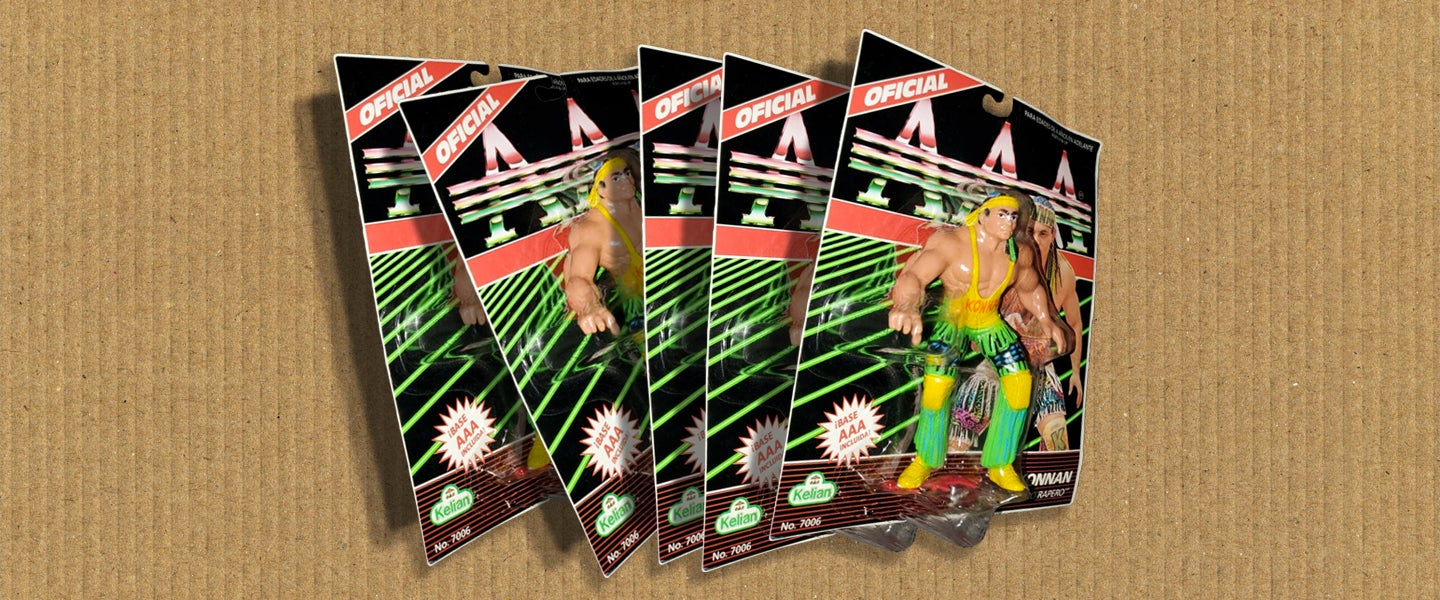When Kevin Kleinrock was scrolling through the #LuchaLibre hashtag on Instagram this past March, he couldn’t believe his eyes. Kleinrock runs Masked Republic, a licensing and merchandise company specializing in Mexico’s unique brand of professional wrestling, and he soon realized that a collectibles vendor in Northern California had posted (and later deleted said post) about acquiring a haul of scarce Mexican action figures from 1994, licensed by AAA, the leading lucha libre promotion of the time. Licensed toys for Mexican wrestlers have been few and far between, and this line has been particularly hard to collect. The vendor, though, told Kleinrock that he “might have a few hundred available,” all sealed in their original packaging. Kleinrock immediately realized that he’d have to dial back his offer to buy everything the vendor had, but he was certainly still willing to buy a lot of them.
Collectibles are weird — especially when they were never meant to be collectibles in the first place. Comic books before the early-1990s boom fall into this category, as do toys before the late 1990s, though the specifics can vary. But collectibles become legitimately collectible due to scarcity, so a sudden increase in supply can serve as anything from a massive disruptor to an ever-present question mark (as with the rare Nintendo game Stadium Events).
The wrestling action figure market, however, is especially fickle and subject to massive swings in value based on what’s gotten hot at what time. Maybe even more so than other collectibles. The first WWF action figure line, produced by LJN, has largely held its value, but otherwise, vintage figure demand has been subject to a number of different pressures. Improvements in modern figures, as well as a significant increase in nostalgic “legends” figures for older fans, can often lead to more recent releases taking precedent, for example, only to lose their value later when priorities shift to a new line. Celebrity collectors, like WWE wrestlers Zack Ryder (real name Matt Cardona) and Curt Hawkins (real name Brian Myers), who do a YouTube series (for WWE) and a podcast (on their own) about the topic, can drive interest in specific figures/lines, too. So can lifelong fans collectively hitting the age where they have the disposable income to build up pristine collections.
The warehouse find that happened earlier this year, though, doesn’t really fit into those categories. AAA was formed in 1992 and still exists to this day, where it’s currently taking aim at American expansion. The same was actually true in the mid-1990s, too, when the promotion first entered the U.S. market, building an incredibly strong business from Spanish-language radio and newspaper advertising. At some point in the middle of this, AAA cut a deal with a company going by the name Kelian. They would make figures of all of AAA’s top stars as well as replicas of the most popular mask in the company, which belonged to the wrestler Octagón.
Mexican shows are famous for the scads of bootleggers outside of the arena, selling handmade masks and hand-painted figures, to the point that the incumbent rival promotion, CMLL, generally refused to bother with licensing altogether. After all, what was the point? But as historian and collector Roy Lucier tells it, AAA founder Antonio Peña saw the potential for revenue from the more polished factory-made products. This is key to the appeal: Official lucha libre figures are a rare and intriguing enough occurrence; a specific assortment being uniquely scarce just makes them all the more collectible.
Beyond that, there’s not a lot known about the AAA toy line. Kleinrock basically only knew the figures were hard to find and whatever Lucier had told him. Meanwhile, information about Kelian is nigh impossible to pin down, and it may have just been a different name for an existing manufacturer. Some clarity, however, was gained after the since-deleted March 27th Instagram post from Iconik Collectables (their spelling), who stumbled upon a warehouse full of the stuff. (Iconik didn’t reply to an Instagram message requesting comment.) This was, ostensibly, where AAA kept them between U.S. shows so it didn’t have to move the merchandise back and forth across the border over and over again, and that’s where they stayed until March.
“I basically asked, ‘What do you have? I’m interested in buying them all,’” Kleinrock tells me. Masked Republic’s Expo Lucha convention was several months away and the figures would be great to sell to attendees. “My only plan was to sell them there for our fans. I didn’t expect them to become the buzz of the wrestling toy podcast community. Having [WWE action figure licensee] Mattel employees coming to our booth at San Diego Comic Con asking to buy them? Totally unanticipated.”
“I knew they went for crazy prices on eBay because of their scarcity, and the numbers we acquired weren’t really going to blow that up too much,” he continues. “But I didn’t see the big picture until San Diego Comic Con and everyone who came to our booth seeking them out.”
“[Iconik was] selling them for $20 apiece,” Lucier tells me. “After Kleinrock bought over half their collection, they deleted the post and raised the price across the board.” As you’d expect, between all of this, it’s now much easier and less expensive to get a pristine Kelian figure in its original packaging. In terms of price, Kleinrock still sells a few on his LuchaShop web store for $50 to $100 each, with similar prices available on eBay. That’s, of course, considerably more than a new toy, but for what had long been incredibly hard to find from at least the mid-1990s, it’s a bargain.
Which isn’t to say there isn’t massive collectible value left for some of them — especially for those of Rey Misterio Jr., the wrestler now known as Rey Mysterio. A pristine version in a protective case went for a whopping $1,500 recently, and even a lightly scuffed one with two missing fingers can fetch a cool $25. It’s enough, honestly, to bring joy to even the most decorated of collectors.
BIG thanks to @TheCurtHawkins for the AAA Kelian Rey Jr. I so desperately needed.
…sorry Broski @ZackRyder @MajorWFPod pic.twitter.com/o9T4Ejuzo0
— WRESTLING GENIUS (KASH-US) (@KassiusOhno) September 16, 2019

